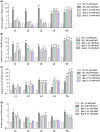Extracellular matrix regulation of stress response genes during larval development in Caenorhabditis elegans
- PMID: 36000892
- PMCID: PMC9635657
- DOI: 10.1093/g3journal/jkac221
Extracellular matrix regulation of stress response genes during larval development in Caenorhabditis elegans
Abstract
Mutation or loss of 6 extracellular matrix collagen genes disrupts annular furrows in adult C. elegans cuticles, causes a wide "Dumpy" body morphology, and activates osmotic, detoxification, and antimicrobial defense genes. High environmental osmolarity reduces internal turgor pressure, physically distorts the epidermis, and activates the same stress responses. Collagen gene mutations that cause Dumpy without furrow disruption do not activate stress responses. These results are consistent with an extracellular damage sensor associated with furrows in the adult cuticle that regulates environmental stress responses in adjacent cells. Several cuticle characteristics change between molts, but all stages have annular furrows and express furrow collagen genes. We compared body shape, furrow organization imaged with differential interference contrast microscopy, and stress response gene expression in furrow collagen gene mutants at all postembryonic stages. We find that most body shape and furrow disorganization phenotypes start at the L3 stage and increase in severity with each molt afterwards. Stress response genes were induced the strongest in adults, correlating with the greatest Dumpy and furrow phenotypes. Although weaker than in adults, osmolyte transporter gene hmit-1.1 and antimicrobial gene nlp-29 were also induced in some early larvae that had weak or undetectable cuticle phenotypes. Our data are consistent with progressive cuticle phenotypes in which each new cuticle is at least partially directed by organization of the former cuticle. Gene expression and cuticle data support the role of furrow disruption as a signal in L4 larvae and adults, but also suggest a role for other cuticle organization or epidermal cell effects in early larvae.
Keywords: Caenorhabditis elegans; development; extracellular matrix; stress response.
© The Author(s) 2022. Published by Oxford University Press on behalf of Genetics Society of America.
Figures




Similar articles
-
RNAi screening for modulators of an osmo-sensitive gene response to extracellular matrix damage reveals negative feedback and interactions with translation inhibition.PLoS One. 2023 May 8;18(5):e0285328. doi: 10.1371/journal.pone.0285328. eCollection 2023. PLoS One. 2023. PMID: 37155688 Free PMC article.
-
A Damage Sensor Associated with the Cuticle Coordinates Three Core Environmental Stress Responses in Caenorhabditis elegans.Genetics. 2018 Apr;208(4):1467-1482. doi: 10.1534/genetics.118.300827. Epub 2018 Feb 27. Genetics. 2018. PMID: 29487136 Free PMC article.
-
An extracellular matrix damage sensor signals through membrane-associated kinase DRL-1 to mediate cytoprotective responses in Caenorhabditis elegans.Genetics. 2022 Mar 3;220(3):iyab217. doi: 10.1093/genetics/iyab217. Genetics. 2022. PMID: 34849856 Free PMC article.
-
The Caenorhabditis elegans cuticle and precuticle: a model for studying dynamic apical extracellular matrices in vivo.Genetics. 2024 Aug 7;227(4):iyae072. doi: 10.1093/genetics/iyae072. Genetics. 2024. PMID: 38995735 Free PMC article. Review.
-
Structures and functions of collagens in Caenorhabditis elegans.FASEB J. 1994 Mar 1;8(3):329-36. doi: 10.1096/fasebj.8.3.8143939. FASEB J. 1994. PMID: 8143939 Review.
Cited by
-
Endogenous gpdh-1 transcriptional reporters as new tools for the study of the osmotic stress response.MicroPubl Biol. 2023 Mar 22;2023:10.17912/micropub.biology.000818. doi: 10.17912/micropub.biology.000818. eCollection 2023. MicroPubl Biol. 2023. PMID: 37033710 Free PMC article.
-
RNAi screening for modulators of an osmo-sensitive gene response to extracellular matrix damage reveals negative feedback and interactions with translation inhibition.PLoS One. 2023 May 8;18(5):e0285328. doi: 10.1371/journal.pone.0285328. eCollection 2023. PLoS One. 2023. PMID: 37155688 Free PMC article.
-
Acquired stress resilience through bacteria-to-nematode interdomain horizontal gene transfer.EMBO J. 2023 Dec 11;42(24):e114835. doi: 10.15252/embj.2023114835. Epub 2023 Nov 13. EMBO J. 2023. PMID: 37953666 Free PMC article.
-
P-hydroxybenzaldehyde protects Caenorhabditis elegans from oxidative stress and β-amyloid toxicity.Front Aging Neurosci. 2024 May 22;16:1414956. doi: 10.3389/fnagi.2024.1414956. eCollection 2024. Front Aging Neurosci. 2024. PMID: 38841104 Free PMC article.
-
Increased expression of metabolism and lysosome-associated genes in a C. elegans dpy-7 cuticle furrow mutant.MicroPubl Biol. 2024 Jul 31;2024:10.17912/micropub.biology.001241. doi: 10.17912/micropub.biology.001241. eCollection 2024. MicroPubl Biol. 2024. PMID: 39144098 Free PMC article.
References
-
- Choe KP. Physiological and molecular mechanisms of salt and water homeostasis in the nematode Caenorhabditis elegans. Am J Physiol Regul Integr Comp Physiol. 2013;305(3):R175–R186. - PubMed
Publication types
MeSH terms
Substances
Associated data
Grants and funding
LinkOut - more resources
Full Text Sources
